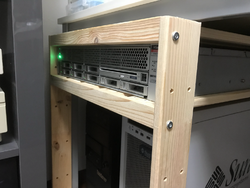Yuri
yuri is my primary server.
Etymology
The machine arrived in July, at the beginning of summer proper in Japan (around 梅雨明け). "Yuri" (百合) in Japanese means lily, which is associated with summer. It is also an allusion to the rackmount server form factor that is long and slim, like a lily flower.
History
My previous Solaris server was a ThinkServer TS130, which was surprisingly capable at running a pile of zones, but its lack of cores, memory, and disk bays were always an issue. I was interested in going SPARC for mostly aesthetic, but some practical reasons (OpenBoot and integration with Sun ILOM's console are very nice), but the modern hardware tends to be unwieldy, and anything newer than an UltraSPARC III commanded an exorbitant price in a small used market obviously still geared towards enterprise.
In 2019, I began to notice inexpensive SPARC Enterprise M3000s appearing on online auctions, but these were still not quite modern enough; Solaris 11.4, released the previous year, had dropped support for them. I eventually noticed the occasional SPARC T4-1, though, which happened to be the new minimum spec for modern Solaris. Two appeared on Yahoo! Auctions in July with no RAM or disks for ¥20,000 each, so I decided to buy one. Fortunately, Sun 2.5" drive sleds were easy to source, and DDR3 RDIMMs were relatively cheap, so adding the missing pieces was no trouble.
After arc, I swore off rackmount equipment mostly over noise concerns, but my new apartment at the time had a small third bedroom with its own climate control that I took advantage of to run a SPARC server without suffering for it in the rest of the house. I shortened an IKEA HEJNE shelf to create a makeshift cabinet and slid it under a desk in the corner. Maintenance access was a pain, but the machine was out of the way and mostly unheard.
yuri spent most of 2021 out of service as I completed yet another international move, running a clone of my infrastructure on a friend's VMware stack. Eventually, though, I tracked down the correct rail kit and installed it in a short rack in a back room in my new house, trying to take a similar approach as before. File services came back in November, and a year later, after some drawn-out indecision on where to source static IP addresses from, I finally brought Internet services back from the temporary environment.
Performance
The things you may have heard about Niagara CPUs are true, and yuri is objectively very slow. With 64 CPU threads and a high RAM ceiling, though, it is competent at juggling many low-intensity tasks like small web and mail servers, which is exactly what I use it for.
Slot Configuration
- PCIE3 LSI SAS9207-8e HBA
- PCIE4 AREA SD-PEU3RB-2L USB 3.0 Card
History
- 2020-10-31 Added USB 3.0 card to handle backups.
- 2019-08-25 Entered production service.
- 2019-07-25 Delivered.
External Links
- SPARC T4-1 Server Documentation - Oracle Help Center
- UNIX Server SPARC T4-1 specification - Fujitsu Global
| akagi 2013-2019 |
tsundoku primary server 2019- |
Current |
